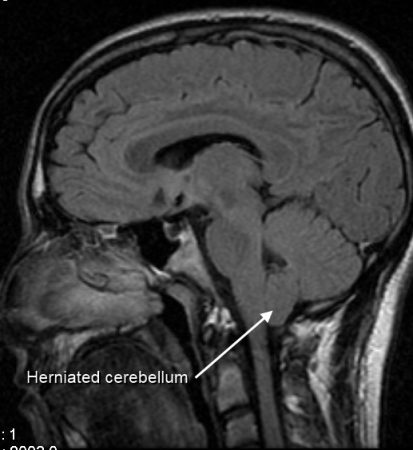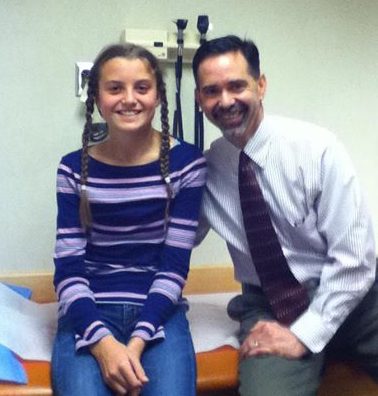If you were to meet Heidi Fox — a 20-year-old college student from Maine — it would probably never occur to you that she was anything but well and healthy.
That’s exactly how it was when she was 13 and in the eighth grade. Up until that point, everything seemed normal and then, her soccer coach suddenly stopped playing her in games.
I said I’m working really hard, why aren’t you letting me play? And he said, it looks like you’re in pain when you’re running. I didn’t feel like I was in pain, but I had a limp that got worse and worse really fast. And then, I did start noticing that I was walking weird, but there still wasn’t any pain for me.
Heidi Fox
Her parents took her to the pediatrician and by then, she wasn’t able to stand on her toes. Again, no pain, she just couldn’t do it.
The pediatrician did some strength testing and said she’s got some weakness in her lower legs, so let’s try some physical therapy. The physical therapist worked with her for maybe 20 minutes the first day and he looked at us and said something is really not right here. He called her pediatrician and the next thing we knew, we were taking her for an MRI.
Brian Fox, Heidi’s father
The MRI showed what appeared to be a cyst in Heidi’s spine. She was scheduled to have back surgery when the pediatric neurosurgeon who was now on her case, decided to order a second MRI with contrast to make sure the cyst wasn’t cancerous.
Instead of only looking at her spine, the radiologist who did the second MRI decided to also take a look at Heidi’s skull. He discovered that she didn’t have a cyst, but a rare condition called Chiari (key-AR-ee) malformation.

Her cerebellum, which is the part of the brain that controls balance, coordination and muscle movement, had pushed through the hole at the bottom of her skull. The hole is called the foramen and it’s meant only for the spinal cord.
Chiari usually occurs because the part of the skull that holds the cerebellum did not develop properly — it’s either too small or misshapen. It’s primarily congenital but has been known to happen with trauma, although rarely.
When the brain extends down into the foramen, the blockage can prevent spinal fluid from circulating as it should between the brain and the spinal canal. The spinal fluid gradually collects where it shouldn’t and causes increased pressure on the brain and spinal cord, which can lead to a variety of symptoms.
Heidi’s parents were filled with gratitude that the radiologist decided to look at her spine and her head.
Instead of just having a cyst in her back, her whole spinal column was fluid filled with one spot that was more swollen. That was the reason the radiologist went beyond. We wrote a letter of thanks because he went way beyond where he was supposed to and we said thank God you took the initiative to do that. Had he not gone up and seen the Chiari then she would have had a back surgery she didn’t need.
Lili Fox, Heidi’s mother
Signs and symptoms of Chiari malformation
Signs of Chiari may be present on a prenatal ultrasound, at birth, or as in Heidi’s case, may not show up until adolescence or early adulthood. Some people may never have any symptoms at all and may only discover they have Chiari when tests are done for other reasons.
The symptoms that kept Heidi out of her soccer games came on quite suddenly.
Two weeks before we were visiting friends in North Carolina and they did this crazy little YouTube video. She was running and there was absolutely nothing wrong. Within a two week period, it reached that point. It was crazy fast.
Lili
Here’s a list of common Chiari signs and symptoms:
- Unsteady gait and problems with balance
- Poor hand coordination
- Neck pain
- Numbness and tingling in the hands and feet
- Dizziness
- Difficulty swallowing
- Blurred or double vision
- Hoarseness
- Severe headaches, especially with sudden sneezing, coughing or straining
- Tinnitus (ringing/buzzing in the ears
- Weakness
- Slow heart rate
- Scoliosis (curvature of the spine)
- Sleep apnea
Treatment

The fact that Heidi had Chiari malformation and not a cyst meant instead of back surgery she needed brain surgery. Not to cure her condition because it isn’t curable, but to prevent things from getting any worse.
The neurosurgeon removed a small section of bone in the back of her skull, which gave her brain more room and relieved the pressure from the build-up of spinal fluid. The procedure is called a posterior fossa decompression. He also cut open the covering of her brain (dura mater) and sewed in a patch to provide some additional room.
In some cases, a small portion of the spinal column is also removed to allow more room and relieve pressure on the spinal cord. If there is a build-up of fluid in the brain, it may also be necessary to put in a tube called a shunt to drain the excess fluid.

Heidi made it through her surgery fine. In fact, her main concern was that she might miss a favorite TV show that night.
As we pulled into the parking garage at Maine Med, Heidi says to us, how long is this surgery supposed to take? And I said, well, two to three hours. And she said, good, because I want to watch The Voice tonight. Fast forward through the surgery and through recovery. The first thing she said when she woke up, I think it was around 5:30, she asked what time it was. We told her and she said, good, wake me up, I want to watch The Voice.
Brian
About seven years have passed since Heidi’s diagnosis and surgery. She is now a medical biology student at the University of New England. About to enter her junior year and carrying a full course load.
The surgery was a success, but she still deals with some troublesome after effects and related symptoms. She has nerve damage in her feet and it was also discovered that she had scoliosis — a double s-curve in her back.
One specialist told her she needed a rod in her back. Instead, she wore a brace. She was also told that she’d probably never walk normally again. But she and her physical therapist worked tirelessly together for more than four years and today, except for when she’s tired, she walks fine.
The most debilitating Chiari symptoms she has to deal with are fatigue and headaches. They prevent her from doing the sports she used to love and sometimes, from doing anything at all.
I get headaches almost daily and when the pressure changes with the weather. What brings them on really bad and really fast is a jarring motion, anything that involves running and jumping.
Heidi
They start in the back of the head and it’s like if you’re nailing something into a wall. Usually, it spreads and sometimes it’s in one whole half of my head or sometimes it’ll just stay in the back.
Some days I’ll wake up with a headache and I’ll know it’s going to be hard to even get through my classes. Other days I’ll wake up feeling fine and I’ll think I need to get a lot of work done. I don’t know how I’ll feel tomorrow, you know? I try to get my work done as far in advance as I can because I never know.
At the beginning of this post, I said if you were to see her today, it would probably never occur to you that Heidi was anything but well and healthy. That’s because even when she’s not doing well, she often doesn’t let on.
I know that she does not complain. When I say she’s my hero, she is my hero. I know how bad of a debilitating headache she can have or how horrible she’ll feel and she will very rarely say I feel bad.
Lili
But the fact that she’s not apt to complain and usually looks fine can mean that many people don’t have a clue what she might be up against. Her closest friends know and are very supportive, but others not so much. Sometimes, even when she tries to explain.
When I tell people what I have, they have no idea what it is. And it’s just hard when they don’t understand.
Heidi
That’s because she looks okay. She looks normal. You know, it’s really hard on her. She has headaches every day and people want her to go play and they want her to go out partying and she can’t, she can’t. She can make the choice — one day I’m going to dance with my friends or I’m going to run down that hill. And then she suffers from headaches but if you look at her, you don’t see it.
Lili
Heidi decided that instead of staying silent about her Chiari she would become an advocate not only for herself but also for other people with rare, invisible diseases. She also decided to go into the medical field after college.
I want to be able to help people who are in situations similar to mine and experience pain every day but feel misunderstood because their pain might not be obvious to other people. I want to be able to help people who also have conditions that most people haven’t heard of, and be someone who can relate to and help them through their experiences.
Heidi
Chiari malformation resources
You can find a lot more information about Chiari malformation on the Conquer Chiari website. The organization sponsors walk every year, including two in Maine.




Leave A Comment